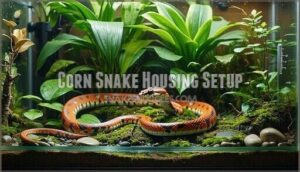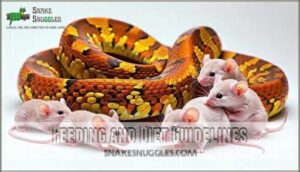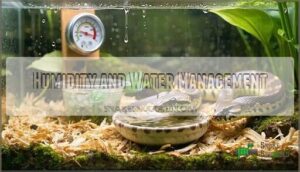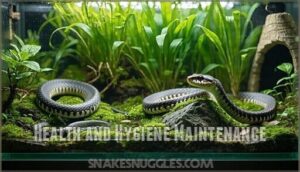This site is supported by our readers. We may earn a commission, at no cost to you, if you purchase through links.
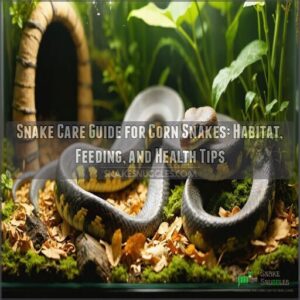
Maintain a temperature gradient: warm side at 85°F, cool side around 75°F, and use a thermostat to regulate heat. Offer hiding spots on both ends, as snakes love cozy corners.
Use aspen shavings or reptile carpet as bedding, and keep humidity around 40-50%. Feed appropriately sized frozen-thawed mice every 7-10 days, adjusting for age and size.
Always provide fresh water. Want tips on enrichment or spotting health issues? Keep reading to learn more.
Table Of Contents
- Key Takeaways
- Corn Snake Housing Setup
- Heating and Lighting Requirements
- Feeding and Diet Guidelines
- Humidity and Water Management
- Health and Hygiene Maintenance
- Frequently Asked Questions (FAQs)
- How to take care of a corn snake for beginners?
- How often should corn snakes be held?
- How do I care for a corn snake?
- How can one get rid of a corn on the foot?
- How do I choose a corn snake?
- How to keep a corn snake healthy and happy?
- How to take care of corn snakes for beginners?
- What do corn snakes need in their enclosure?
- Are corn snakes high maintenance?
- Do corn snakes like to be held?
- Conclusion
Key Takeaways
- Keep the enclosure secure, maintain a temperature gradient (85°F warm side, 75°F cool side), and provide hiding spots on both ends.
- Use aspen shavings or reptile carpet for bedding, keep humidity at 40-50%, and always have fresh water available.
- Feed frozen-thawed mice weekly, adjusted for size and age, and avoid live feeding to prevent injuries.
- Regularly monitor your snake’s health, ensure clean environments, and handle gently to avoid stress.
Corn Snake Housing Setup
Creating the perfect housing setup for your corn snake is essential for their health and comfort.
You’ll need a secure, properly sized enclosure with features like hiding spots, ventilation, and temperature control to mimic their natural environment, ensuring their overall comfort.
Choosing The Right Enclosure Size
Start small for hatchlings with enclosures like a 2ft vivarium to ease stress.
Adults need a corn snake enclosure at least 4ft long, guaranteeing they can fully stretch.
Vertical space supports enrichment needs like climbing.
As your snake grows, plan enclosure upgrades for comfort.
Proper snake enclosure setup guarantees healthy development, matching snake size with vivarium dimensions.
Types of Enclosures for Corn Snakes
You’ve decided on the right size for your corn snake enclosure; now, consider your options.
Wooden vivariums retain heat well and support humidity control. Glass tanks show off your snake but can need extra insulation. Plastic tubs work for smaller setups, while rack systems suit breeders.
Custom enclosures let your creativity shine! Some owners buy specialized snake enclosures for their pets.
- Wooden Vivariums: Excellent heat retention.
- Glass Tanks: Aesthetic but harder to heat.
- Plastic Tubs: Affordable, simpler designs.
- Rack Systems: Perfect for multiple snakes.
Ventilation and Security Considerations
Proper ventilation and security are essential for your corn snake’s safety.
Use a mesh lid for good airflow design, ensuring it’s escape-proof.
Vivarium locks add security, while tight-fitting lids prevent their sneaky escapes.
Place mesh strategically to avoid drafts but maintain ventilation.
A well-secured snake terrarium balances air circulation and prevents escape risks, making snake care stress-free, with a focus on security.
Decor and Hiding Places
Your corn snake will appreciate thoughtful enclosure enrichment. Include safe materials like climbing branches, leafy cover, and a good substrate depth for burrowing.
Snake hides are essential for security—place them in both warm and cool areas. A naturalistic design with vivarium decoration mimics their habitat.
Snake enrichment guarantees they feel secure while exploring and hiding, supporting excellent corn snake care. Consider using aspen or coconut fiber for the substrate to ensure a comfortable and stimulating environment for your corn snake.
Heating and Lighting Requirements
Your corn snake’s health depends on providing the right heat and lighting in their enclosure.
Creating a proper temperature gradient and maintaining a regular day-night light cycle will support their natural habits and overall well-being.
Ideal Temperature Gradient for Corn Snakes
Maintaining the right temperature gradient is essential for your corn snake’s health.
Aim for a basking spot temp of 30-32°C and a cool zone temp of 22-25°C.
At night, allow a safe nighttime drop to 18-20°C.
Use thermostat control to regulate temperatures, ensuring consistency, and monitoring is key to adjust for seasonal variation which may slightly adjust these snake temperature requirements.
Heat Lamp Options and Safety Precautions
To meet snake temperature requirements, consider Ceramic Heaters or Deep Heat Projectors.
These heat lamps provide steady warmth and are safer than bulbs.
Use thermostat control to regulate temperature and avoid overheating.
Check bulb wattage to match your enclosure’s size.
For burn prevention, secure heating elements out of reach.
Consider a safe heat source for your snake.
Always monitor your snake’s heating methods for consistent temperature regulation, using thermostat control and ensuring a safe heat source.
UVB Lighting and Its Importance
UVB lighting isn’t a must for corn snakes, but it can boost snake health by supporting bone strength and mimicking natural sunlight.
Use low-intensity UVB bulbs, and remember, distance matters—too close causes harm.
Stick to proper lighting schedules and check bulbs regularly.
Corn snake lighting setups with UVB benefits create a healthier environment for your reptile, helping prevent metabolic bone disease by ensuring the right conditions, and this is crucial as seen in the link to metabolic bone disease.
Replace bulbs as needed to maintain the health of your reptile and support overall snake health.
Maintaining a Day-Night Cycle
Your corn snake relies on a steady day-night cycle to maintain its circadian rhythm and overall well-being.
Keep light duration at 12 hours daily using snake lighting that mimics natural conditions.
Temperature shifts between day and night should align with seasonal variations, and proper snake UVB lighting guarantees behavioral changes like basking and activity.
Creating a natural, healthy snake habitat is crucial, and by following these guidelines, you can ensure your snake thrives in its environment with a stable day-night cycle.
Feeding and Diet Guidelines
Feeding your corn snake properly is essential for its health and growth. You’ll need to provide appropriately sized, defrosted prey on a schedule that matches its age and size.
Components of a Corn Snake Diet
A proper corn snake diet includes frozen-thawed mice, sized slightly larger than your snake’s widest point.
Stick to prey like mice or quails for balanced snake nutrition.
Avoid live feeding—it’s risky.
Dietary variety isn’t mandatory but can include occasional rats.
Supplementation needs are minimal if prey quality is high.
Prey size and preparation guarantee safe, healthy snake feeding.
Feeding Guidelines Based on Age and Size
Young snakes like hatchlings need frequent meals of small pinky mice, while juveniles graduate to larger portions as they grow.
Adults eat less often, typically one appropriately-sized prey item every 7–14 days.
Always choose prey slightly wider than your snake’s body, following these snake feeding guidelines that support a healthy corn snake diet and help avoid issues like obesity.
Prey Options and Feeding Techniques
For corn snakes, frozen-thawed prey is safer than live, reducing injury risks.
Start hatchlings with pinky mice, and gradually match prey size to the widest part of the snake’s body. Adult mice suit larger snakes.
For a reliable source, one might consider purchasing frozen rodents.
Follow feeding frequency guidelines—every 7-14 days for adults. Handle snake prey carefully to avoid contamination and minimize refusal reasons during feeding.
Supplementing With Calcium and Vitamins
When feeding, snake supplements like calcium and vitamin D3 can help prevent calcium deficiency – a key factor in reptile health.
Lightly dust prey every other feeding with calcium powder, especially if UVB lighting isn’t used.
Breeding females or snakes with vitamin needs may benefit most from these supplements, and it is crucial to avoid over-supplementing risks by checking your snake’s health and diet regularly, focusing on preventing deficiency.
Humidity and Water Management
Keeping your corn snake’s environment at the right humidity is essential for their health and well-being.
You’ll also need to provide fresh water and monitor moisture levels to guarantee proper hydration and healthy shedding, which is crucial for their overall well-being.
Maintaining Optimal Humidity Levels
Snake humidity levels matter for healthy shedding and overall well-being. Aim for 40-50%, using a hygrometer to check daily.
Too much moisture invites respiratory infections, so control substrate moisture carefully. Adding a humidity hide with damp sphagnum moss helps during shedding.
Place the hygrometer at mid-enclosure height for accuracy. Adjust with ventilation or light misting if needed.
Providing a Water Bowl and Hiding Places
A water bowl should be shallow yet large enough for your corn snake to soak comfortably.
Place it in a shaded area to prevent rapid evaporation.
When setting up hides, provide at least two: one warm, one cool, and use sturdy materials like cork bark.
Clean the water bowl and hides weekly to prevent bacteria buildup and guarantee your snake’s comfort.
Substrate Options and Moisture Control
A snake’s substrate is its foundation, influencing health and comfort.
Opt for aspen shavings, cypress mulch, or soil for natural burrowing behavior and humidity control.
Avoid anything that retains excessive moisture to prevent mold and scale rot.
A good choice will mimic their natural habitat for superior health.
| Substrate Types | Humidity Control | Mold Prevention | Shedding Aid |
|---|---|---|---|
| Aspen Shavings | Moderate | Excellent | Limited |
| Cypress Mulch | High | Good | Effective |
| Soil | Moderate | Good | Effective |
| Paper Towels | Minimal | Excellent | Minimal |
Misting and Monitoring Humidity
To keep corn snake humidity levels consistent, use a hygrometer.
Place it near the enclosure’s cool side to monitor accurately.
Misting frequency depends on your snake’s shedding humidity needs—aim for 40-50%, increasing to 70% during shedding.
Substrate choice affects snake hydration, so avoid overly dry materials.
Address humidity problems with light misting or a moist hide.
Health and Hygiene Maintenance
Keeping your corn snake healthy means regularly watching for signs of illness and staying on top of their care.
Regular checkups and clean environments ensure your corn snake stays active, stress-free, and thriving in its habitat.
Routine checks and a clean environment go a long way in preventing problems and keeping your pet thriving.
Recognizing Signs of Illness and Stress
Watch for key snake health indicators like lethargy, appetite loss, abnormal shedding, or regurgitation, as these signs often reveal common illnesses.
Respiratory issues, like wheezing or open-mouth breathing, highlight possible stress or infection.
Unusual snake behavior, such as excessive hiding, can signal health concerns, and regular observation helps you spot problems early, ensuring your corn snake stays healthy and stress-free.
Regular observation is crucial for maintaining the health of your corn snake.
Monitoring Weight and Growth
After spotting early signs of stress, focus on tracking your corn snake’s weight and growth rate.
Weigh your snake regularly using a scale to guarantee it maintains an ideal weight. Monitor body condition and shedding frequency—each affects corn snake size.
To prevent infections, maintain proper ventilation within their enclosure.
For baby corn snakes, steady growth and proper snake weight management, supported by balanced feeding, signal healthy development and require careful attention to their growth rate.
Performing Routine Health Checks
Check your corn snake’s health regularly by observing scale condition, shedding problems, and body condition.
Look for behavioral changes, like sluggishness, which can indicate illness.
Watch for respiratory issues, such as wheezing or open-mouth breathing.
A healthy snake shows smooth scales, regular shedding, and normal movement.
Routine snake health monitoring guarantees your pet stays active and in good shape, ensuring a long and healthy life with regular shedding.
Seeking Veterinary Care When Necessary
If your corn snake shows emergency symptoms like respiratory distress or prolonged anorexia, visit a reptile vet immediately.
Finding vets with snake expertise guarantees proper treatment for common ailments like stuck shed or infections.
Preventative care, including health monitoring, reduces risks.
After treatment, prioritize post-treatment care to aid recovery and address snake common illnesses effectively.
Always prioritize your snake’s well-being.
Frequently Asked Questions (FAQs)
How to take care of a corn snake for beginners?
Caring for a corn snake isn’t as slippery as it sounds.
Keep their vivarium secure, maintain a temperature gradient, provide clean water, and feed thawed mice weekly.
Create hiding spots and monitor humidity levels closely, which involves closely checking the environment to ensure the snake’s health and well-being.
How often should corn snakes be held?
Handle your corn snake 1-2 times a week to keep it used to human interaction.
Don’t overdo it—handling too often can stress them out, especially after feeding or during shedding.
Always move gently and calmly.
How do I care for a corn snake?
Start small with space, simple supplies, and steady temperatures.
Provide a secure enclosure, a thermal gradient, fresh water, and defrosted rodents weekly.
Add hiding spots, monitor humidity, and handle gently for a happy, healthy snake, ensuring a secure environment.
How can one get rid of a corn on the foot?
Soak your foot in warm water to soften the corn, then gently file it with a pumice stone.
Use a corn pad to reduce friction, and apply moisturizer daily to prevent dryness.
How do I choose a corn snake?
Did you know corn snakes come in over 800 color morphs?
Choose one with healthy scales, clear eyes, and a calm demeanor.
Avoid snakes with visible injuries or lethargy for the best experience.
How to keep a corn snake healthy and happy?
Provide a spacious, secure enclosure with proper heat and humidity levels, fresh water, and suitable substrate.
Feed appropriately sized prey every 7-14 days, maintain hiding spots, and guarantee regular health checks for long-term wellbeing.
How to take care of corn snakes for beginners?
Caring for corn snakes is a breeze compared to raising a zoo.
Keep their vivarium cozy with proper heat, humidity, and hiding spots.
Feed defrosted mice, make certain fresh water daily, and handle gently.
What do corn snakes need in their enclosure?
Your corn snake’s enclosure needs secure hiding spots, a temperature gradient, proper humidity, and a clean substrate.
Add a water bowl, climbing branches, and enough space for the snake to stretch comfortably.
Are corn snakes high maintenance?
Meeting their needs is simple, not stressful.
Corn snakes are low-maintenance pets—feed them weekly, clean their enclosure regularly, and monitor temperature.
Unlike needy pets, they thrive with basic care and minimal handling.
Easy, right?
Do corn snakes like to be held?
Corn snakes tolerate being held if handled gently and regularly, but they don’t crave human interaction like pets.
Limit sessions to 10-15 minutes, ensuring they feel secure and aren’t shedding, digesting, or stressed.
Conclusion
Caring for a corn snake might feel like a big leap at first, but with the right setup, it’s a smooth process.
A secure habitat, proper heating, balanced humidity, and fresh water are essentials.
Feed appropriately sized prey and monitor their health regularly, remembering that consistency is key.
By following this snake care guide for corn snakes, you’ll create a thriving environment for your pet, ensuring a happy and healthy companion for years to come.

